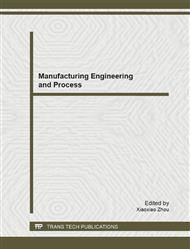[1]
JANIA, Z. J, Friction-clutch Transmissions, parts (1-4), Machine Design 1958, Vol. 30, Nos. 23, 24, 25 and 26.
Google Scholar
[2]
NEWCOMB, T. P, Calculation of Surface Temperatures Reached in Clutches When the Torque Varies with Time, J. Mech. Engng. Sci., 1961, 3, pp-340.
DOI: 10.1243/jmes_jour_1961_003_046_02
Google Scholar
[3]
DUNDORE, M. W. and SCHNEIDER, R. C, Clutch Energy-A criteria of Thermal Fatigue, SAE Trans. 1968, paper No. 680582.
Google Scholar
[4]
KULEV. V. A, HEATING Calculations in Friction clutch Design, Russian Eng. J. 1972, No. 9, pp.24-27.
Google Scholar
[5]
E. J. Berger, F. Sadeghi, and C. M. Krousgrill, Finite Element Modeling of Engagement of Rough and Grooved Wet Clutches, ASME Paper 95-TRIB-6, Joint ASME/STLE Tribology Conference, Orlando, FL, October (1995).
DOI: 10.1115/1.2837069
Google Scholar
[6]
YongG. Lai , Transient Effects On Heat Conduction In Sliding Bodies, Numerical Heat Transfer, Part A: Applications, 1998, Vol. 33, No. 6, pp.583-597.
Google Scholar
[7]
R. A. Tatara and Parviz Payvar, Multiple Engagement Wet Clutch Heat Transfer Model, Numerical Heat Transfer, Part A: Applications, 2002, Vol. 42, No. 3, pp.215-231.
DOI: 10.1080/10407780290059512
Google Scholar
[8]
T. C. Kennedy and S. Traiviratana, Transient Effects On Heat Conduction In Sliding Bodies, Numerical Heat Transfer, Part A: Applications, 2004, Vol. 47, No. 1, pp.57-77.
DOI: 10.1080/10407780490520788
Google Scholar
[9]
V. P. Sergienko, M. Yu., Tseluev, and A. V. Kupreev Numerical Simulation of Thermal Conditions in the Oil_Cooled Friction Multidisc Clutch of a Power Intensive Wheel Tractor, J. of friction and wear, 2010, vol. 31, No. 4, p.353–363.
DOI: 10.3103/s1068366610040033
Google Scholar
[10]
A. A. Yevtushenko and P. Grzes, The Fem-Modeling Of The Frictional Heating Phenomenon In The Pad/Disc Tribosystem, Numerical Heat Transfer, Part A: Applications, 2010, Vol. 58, No. 3, pp.207-226.
DOI: 10.1080/10407782.2010.497312
Google Scholar
[11]
A. Yevtushenko and P. Grzes, Finite Element Analysis Of Heat Partition In A Pad/Disc Brake System, Numerical Heat Transfer, Part A: Applications, 2011, Vol. 59, No. 7, pp.521-542.
DOI: 10.1080/10407782.2011.561098
Google Scholar
[12]
A C Ugural. Mechanical Design,. McGraw-Hill Professional, (2004).
Google Scholar
[13]
F. F. Ling, A Quasi-Iterative Method for Computing Interface Temperature Distributions, Zeitschrift fu¨ r angewandte Mathematik und Physik (ZAMP), vol. 10, no. 5, p.461–474, (1959).
DOI: 10.1007/bf01601355
Google Scholar
[14]
11. H. Blok, Fundamental Mechanical Aspects in Boundary Lubrication, SAE Trans., vol. 46, p.54–68, (1940).
Google Scholar
[15]
O. C. Zienkiewicz, The Finite Element Method, McGraw-Hill, New York, (1977).
Google Scholar
[16]
NEWCOMB, T. P, Temperature Reached in Friction Clutch Transmissions, J. Mech. Engng. Sci., 1960, 2, pp-273.
Google Scholar


